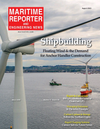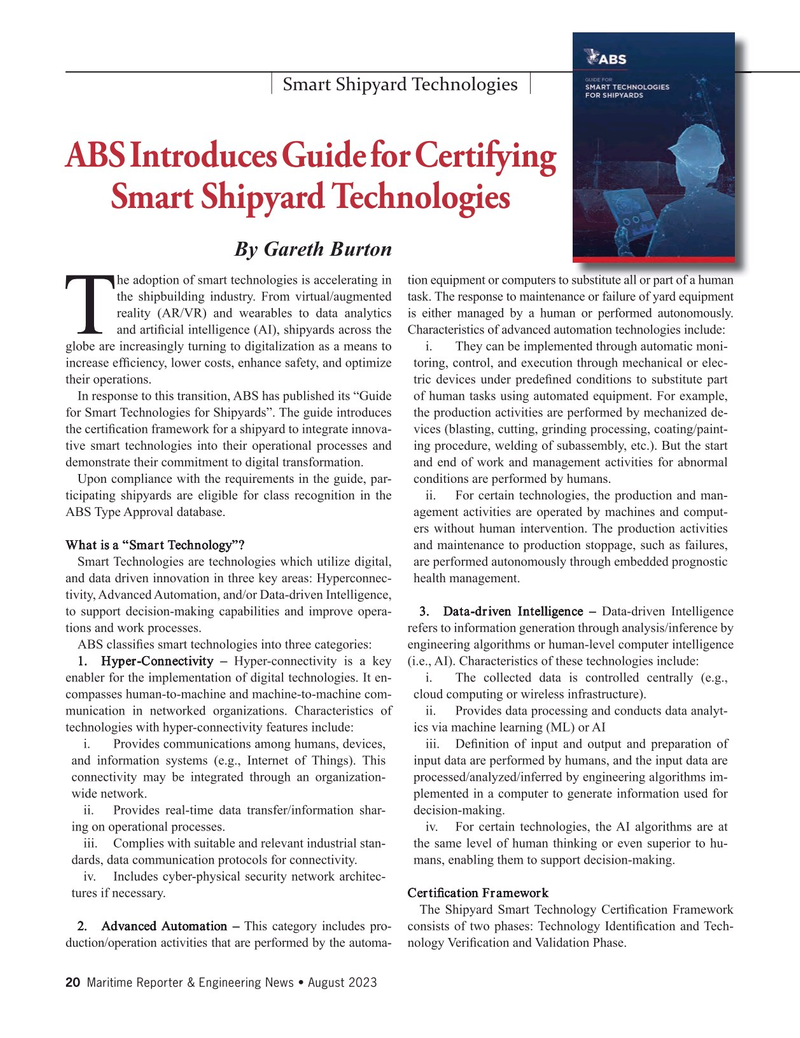
Page 20: of Maritime Reporter Magazine (August 2023)
Shipyard Annual
Read this page in Pdf, Flash or Html5 edition of August 2023 Maritime Reporter Magazine
Smart Shipyard Technologies
ABS Introduces Guide for Certifying
Smart Shipyard Technologies
By Gareth Burton substituteallorpartofahuman he adoption of smart technologies is accelerating in tion equipment or computers to substitute all or part of a human the shipbuilding industry. From virtual/augmented task. The response to maintenance or failure of yard equipment reality (AR/VR) and wearables to data analytics is either managed by a human or performed autonomously.
Tand arti? cial intelligence (AI), shipyards across the Characteristics of advanced automation technologies include: globe are increasingly turning to digitalization as a means to i. They can be implemented through automatic moni- increase ef? ciency, lower costs, enhance safety, and optimize toring, control, and execution through mechanical or elec- their operations. tric devices under prede? ned conditions to substitute part
In response to this transition, ABS has published its “Guide of human tasks using automated equipment. For example, for Smart Technologies for Shipyards”. The guide introduces the production activities are performed by mechanized de- the certi? cation framework for a shipyard to integrate innova- vices (blasting, cutting, grinding processing, coating/paint- tive smart technologies into their operational processes and ing procedure, welding of subassembly, etc.). But the start demonstrate their commitment to digital transformation. and end of work and management activities for abnormal
Upon compliance with the requirements in the guide, par- conditions are performed by humans.
ticipating shipyards are eligible for class recognition in the ii. For certain technologies, the production and man-
ABS Type Approval database. agement activities are operated by machines and comput- ers without human intervention. The production activities
What is a “Smart Technology”? and maintenance to production stoppage, such as failures,
Smart Technologies are technologies which utilize digital, are performed autonomously through embedded prognostic and data driven innovation in three key areas: Hyperconnec- health management.
tivity, Advanced Automation, and/or Data-driven Intelligence, to support decision-making capabilities and improve opera- 3. Data-driven Intelligence – Data-driven Intelligence tions and work processes. refers to information generation through analysis/inference by
ABS classi? es smart technologies into three categories: engineering algorithms or human-level computer intelligence 1. Hyper-Connectivity – Hyper-connectivity is a key (i.e., AI). Characteristics of these technologies include: enabler for the implementation of digital technologies. It en- i. The collected data is controlled centrally (e.g., compasses human-to-machine and machine-to-machine com- cloud computing or wireless infrastructure).
munication in networked organizations. Characteristics of ii. Provides data processing and conducts data analyt- technologies with hyper-connectivity features include: ics via machine learning (ML) or AI i. Provides communications among humans, devices, iii. De? nition of input and output and preparation of and information systems (e.g., Internet of Things). This input data are performed by humans, and the input data are connectivity may be integrated through an organization- processed/analyzed/inferred by engineering algorithms im- wide network. plemented in a computer to generate information used for ii. Provides real-time data transfer/information shar- decision-making.
ing on operational processes. iv. For certain technologies, the AI algorithms are at iii. Complies with suitable and relevant industrial stan- the same level of human thinking or even superior to hu- dards, data communication protocols for connectivity. mans, enabling them to support decision-making.
iv. Includes cyber-physical security network architec- tures if necessary. Certi? cation Framework
The Shipyard Smart Technology Certi? cation Framework 2. Advanced Automation – This category includes pro- consists of two phases: Technology Identi? cation and Tech- duction/operation activities that are performed by the automa- nology Veri? cation and Validation Phase.
20 Maritime Reporter & Engineering News • August 2023
MR #8 (18-33).indd 20 8/3/2023 10:52:38 AM

 19
19

 21
21
